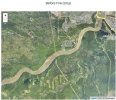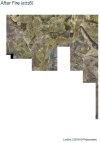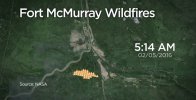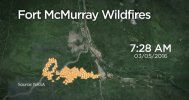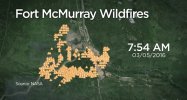I have been wondering what started the Fort McMurray fires? I know we won't get the truth from official channels unless it was started by human carelessness or lightning strikes. There was no lightning in the area that day, but because of the extremely dry conditions here in Alberta at the time; human error is very possible asteroid/meteor strikes however are also very possible as is the possibility of the fire being started deliberately for some nefarious, resource driven reason as some have speculated due to Trudeau turning down aid from multiple countries. Also, there is the weirdness of our Provincial government for people to sign non-disclosure agreements before they are allowed to enter the city. I know this one is really going to eat at me as it is in my own backyard so to speak.
You are using an out of date browser. It may not display this or other websites correctly.
You should upgrade or use an alternative browser.
You should upgrade or use an alternative browser.
Fort McMurray fires
- Thread starter Meechel17
- Start date
Meechel17 said:I have been wondering what started the Fort McMurray fires? I know we won't get the truth from official channels unless it was started by human carelessness or lightning strikes. There was no lightning in the area that day, but because of the extremely dry conditions here in Alberta at the time; human error is very possible asteroid/meteor strikes however are also very possible as is the possibility of the fire being started deliberately for some nefarious, resource driven reason as some have speculated due to Trudeau turning down aid from multiple countries. Also, there is the weirdness of our Provincial government for people to sign non-disclosure agreements before they are allowed to enter the city. I know this one is really going to eat at me as it is in my own backyard so to speak.
Not sure if you caught this article on SoTT, Meechel17 https://www.sott.net/article/318684-Sott-Exclusive-Cone-of-silence-over-Fort-McMurray-following-devastating-wildfire-ANYONE-going-to-ruined-city-must-sign-non-disclosure-agreement
It has not to my understanding been disclosed at to how it started, however, the non-dislclosure aspect is strange. There is still much more data to collect on this fire to have a clear idea of the event and the tactics used or not used.
Here is a basic fire timeline:
4 p.m. Sunday, May 1
When the wildfire that would eventually engulf Fort McMurray was discovered by fire crews on patrol Sunday afternoon. It was just two hectares in size. They immediately jumped on the blaze. Within a couple of hours, four air tankers had also been deployed. Despite their best efforts, by 6 p.m. — just two hours after it was found — it had grown to 60 hectares.
8 p.m. Sunday
Wood Buffalo’s emergency measures department says the south-end fire is moving east and tells people in the Centennial Park Campground, on the west side of Highway 63, to leave their trailers. The municipality warns residents in the Beacon Hill and Gregoire neighbourhoods to be prepared to leave on short notice. An evacuation centre opens on MacDonald Island in the centre of the city. The 120-hectare fire is 4.8 kilometres west of Gregoire, on the west side of the Hangingstone River.
9:57 p.m. Sunday
Mayor Melissa Blake declares a local state of emergency in Gregoire and issues a mandatory evacuation order for at least 500 people in Centennial Park, the Prairie Creek area south of Airport Road, and Gregoire.
Click here for more wildfire coverage
1 a.m. Monday, May 2
The fire reaches 1.2 km west of Highway 63 and Airport Road. It has not yet crossed the Hangingstone River.
3 a.m. Monday
The mandatory evacuation order for Gregoire is lifted to a “shelter in place” order.
5:30 p.m. Monday
The mandatory evacuation order for Prairie Creek is lifted to a “shelter in place” order. Firefighters and heavy equipment hold the fire 1.2 km west of Highway 63. The blaze grows to 1,250 hectares by the end of the day.
11 a.m. Tuesday, May 3
Although firefighters on the east edge of the fire hold the line, the blaze grows substantially to the west and is 2,656 hectares.
Noon Tuesday
Fort McMurray Fire Chief Darby Allen says the fire has crossed the Athabasca River toward the northwest part of town.
2 p.m. Tuesday
People living in Abasand, Grayling Terrace and Beacon Hill receive mandatory evacuation notices. Residents living south of Thickwood Boulevard between Real Martin Drive and Thicket Drive in the Ross Haven neighbourhood, west of the Athabasca River, are told to be ready to leave with 30 minutes notice.
3:10 p.m. Tuesday
The fire reaches the city. Mobile homes in Centennial Park and houses in Abasand begin to burn. Thickwood is under a mandatory evacuation notice.
4 p.m. Tuesday
The mandatory evacuation order expands to include Gregoire, Beacon Hill, Abasand, Waterways, Grayling Terrace, Draper, Saline Creek, downtown, Thickwood, Wood Buffalo, Dickinsfield and the lower townsite.
4:15 p.m. Tuesday
The shelter in MacDonald Island Park is evacuated.
6:25 p.m. Tuesday
All of Fort McMurray is put under a mandatory evacuation order. People leaving share pictures on social media of the Super 8 hotel and Denny’s restaurant near Beacon Hill ablaze. People begin to flee to oilsands camps in the north and other communities in the south on Highway 63, the only major road through Fort McMurray.
9 p.m. Tuesday
Officials report significant fire damage in Beacon Hill, and “light” damage in Abasand, Dickinsfield, Wood Buffalo and Waterways.
11:30 p.m. Tuesday
An evacuation centre opens at Edmonton’s Northlands Expo Centre.
4 a.m. Wednesday, May 4
The fire has destroyed homes in Beacon Hill, Waterways and Abasand. About 80 per cent of homes in Beacon Hill are razed, the municipality estimates. Abasand and Waterways saw “serious loss.” Wood Buffalo has some damage and 12 trailers burned in the Timberlea area. Two houses were destroyed in Dickinsfield and one each in Grayling Terrace, downtown, and Thickwood.
10 a.m. Wednesday
Alberta Forestry estimates the fire is 10,000 hectares. Premier Rachel Notley says approximately 1,600 structures have burned.
12:30 p.m. Wednesday
The regional municipality releases an updated damage assessment. Ninety per cent of the homes in Waterways are gone. Beacon Hill lost 70 per cent of its houses. Half the houses in Abasand burned. Four houses were destroyed and six more damaged in Grayling Terrace. Thirteen trailers were destroyed in Timberlea. About 30 houses were gone in Wood Buffalo. Two houses were obliterated in Dickinsfield, one downtown and one in Thickwood. The premier says an estimated 1,600 structures have been destroyed.
The municipality’s emergency operations centre relocates to Nexen’s Long Lake facility after fire forces it from its Airport Road location.
4:05 p.m. Wednesday
The fire crosses the intersection of Highways 69 and 63, cutting off the main route in and out of the city to the south.
The municipality issues an evacuation order for Saprae Creek in Fort McMurray’s southeast tip. The region issues a boil water advisory.
5:30 p.m. Wednesday
With winds gusting to 70 km/h, the blaze migrates toward the airport and Saprae Creek. Fifteen structures are on fire in Walnut Crescent in the Timberlea area.
6:45 p.m. Wednesday
Canwest Propane catches on fire.
7:15 p.m. Wednesday
The east-moving flames reach Old Airport Road. Three structures are on fire on Blackburn Drive in Parsons Creek. A Catholic school under construction is destroyed.
9:50 p.m. Wednesday
Municipality issues a mandatory evacuation order for Anzac, Gregoire Lake Estates, and Fort McMurray First Nation, which affected approximately 1,000 people. Evacuees who had sought shelter at a reception centre in Anzac were bused to Lac La Biche, Edmonton, and other more southern destinations. The municipality’s emergency operations centre flees to Lac La Biche.
8:30 a.m. Thursday, May 4
The fire spreads to homes, buildings, and a cell tower in north Abasand, the Prospect area, and Old Airport Road. The emergency operations centre moves back to a Fort McMurray firehall. The city is surrounded by fire.
10 a.m. Thursday
The provincial government announces it is instituting a rarely used provincewide fire ban. Premier Rachel Notley declares a provincial state of emergency in the Regional Municipality of Wood Buffalo.
Airlifts begin transporting evacuees lodged at oilsands camps north of Fort McMurray to Edmonton and Calgary.
6 p.m. Thursday
The fire has grown to 85,000 hectares, and is approaching Anzac. The blaze stays five km away from Gregoire Lake Estates.
6 a.m. Friday, May 6
The fire has grown to 101,000 hectares and reached Anzac, destroying 12 structures.
A police-escorted convoy of people who drove to camps north of Fort McMurray begins trickling through the battered town, 50 vehicles at a time.
11:30 a.m. Friday
Premier Rachel Notley announces emergency funds for wildfire evacuees. People pushed out of their homes will receive pre-loaded debit cards worth $1,250 per adult and $500 per dependent.
3 p.m. Friday
Heat and wind prompt forestry officials to predict the Horse River fire will double in size overnight. A new fire, dubbed MWF-015, begins to burn in the forest northeast of Fort McMurray.
The provincial government imposes a provincial ban on using off-road recreational vehicles, such as ATVs, in a move to prevent more fires.
Some evacuees move into residences on the University of Alberta campus.
By the end of the day, the fire had grown to 156,607 hectares. About 7,500 people had driven through Fort McMurray in convoys.
Saturday, May 7
Fort McKay, a community north of Fort McMurray, is placed on a voluntary evacuation order as smoke grows thick. Around 200 people who were elderly or with respiratory problems were airlifted out.
Flights and drivers continue to flow out of northern camps.
Fire officials predict the blaze will soon reach the Saskatchewan border.
Sunday, May 8
The weather turns cooler, and a few showers sprinkle down, prompting Alberta Wildfire’s Chad Morrison to crack a smile and say firefighters might finally begin to “get a death grip” on the blaze. The fire did not grow nearly as much as expected and now stands at 161,197 hectares. Two hundred helicopters and 500 firefighters are working to extinguish the fire.
Nervous that flames might reach the facility, Syncrude shuts down operations, sending 1,500 people from the site.
Atco workers are in Fort McMurray aiming to restore electricity and gas lines. SPCA crews are checking on and feeding pets left behind.
The last of the evacuees holed up in northern camps ship out of the north Sunday morning.
Federal Public Safety Minister Ralph Goodale tours the Northlands evacuation centre and commits to aiding Fort McMurray’s recovery.
The Red Cross reports about 90,000 people from 46,000 households have registered with the organization.
An outbreak of gastroenteritis begins at the Northlands Expo centre. At least 40 evacuees fall ill with nausea, diarrhea, and vomiting, and are quarantined away from the crowd.
Monday, May 9
Premier Notley tours Fort McMurray to survey the damage. She says about 2,400 structures are burned in Fort McMurray, which is approximately 10 per cent of the city.
Alberta Opposition Leader Brian Jean and federal Interim Conservative Leader Rona Ambrose tour the evacuation centre in Lac La Biche, where 2,000 people are housed.
Prime Minister Justin Trudeau turns down international offers of firefighting help from Russia, Mexico, Australia, Taiwan, Israel and the Palestinian Authority.
Officials escort journalists on a media tour of Fort McMurray, to give the public the first detailed look at the damage.
Imperial Oil and the Canadian subsidiary of Statoil close their facilities as a precaution. The Enbridge pipeline that supplies oil to Statoil is also shut.
Alberta Education Minister David Eggen announces Fort McMurray and Anzac students will not have to write diploma exams to get credit for courses or graduate. High school students from the area who do not return to school to finish the year will receive their class marks to date as their final grades.
The fire is now 204,196 hectares and has merged with fire MWF-015 that started independently northeast of Fort McMurray.
Tuesday, May 10
Premier Notley meets with 15 top oil executives to update them on the wildfire’s effects and discuss a plan to restart production. Suncor CEO Steve Williams says it will take companies anywhere from 24 hours to several weeks to increase oil production. None of the facilities sustained fire damage. Highway 63 through Fort McMurray is reopened for commercial vehicles bringing supplies to oilsands operations.
The blaze’s growth slows, reaching 229,078 hectares. It’s around 25 to 30 kilometres from the Saskatchewan border. Around 700 firefighters, 26 helicopters, 13 air tankers, and 46 pieces of heavy equipment, such as bulldozers, are working on the fire. Machines were clearing trees around Parsons Creek and Timberlea to create a buffer around the neighbourhoods. The inferno is still classified as out of control.
On Monday evening, Fort McMurray Fire Chief Darby Allen says, “We think we’ve got this thing beat in McMurray.”
The Fort McMurray SPCA announces a four-day operation to retrieve trapped pets rounded up 244 animals, which were brought to Edmonton.
A job fair at the Argyll Centre in Edmonton seeking 500 workers to help rebuild Fort McMurray attracts more than 1,000 applicants.
Alberta Health Services said a total of 105 evacuees at Northlands have shows symptoms of a gastrointestinal virus.
A Fort McMurray man charged with breaking into two homes after the municipality was evacuated appears in an Edmonton courtroom.
Wednesday, May 11
People who fled Fort McMurray can begin collecting emergency funding this afternoon from the Alberta government and Red Cross. Evacuees can collect $1,250 plus $500 for each child from distribution centres in Edmonton, Lac La Biche, and Calgary.
The Red Cross, which has raised $67 million to aid evacuees, will send electronic transfers of $600 for each adult and $300 for each child registered with the organization within the next two days.
The Regional Municipality of Wood Buffalo holds a council meeting in Edmonton city council chambers — its first meeting since the fire.
Thursday, May 12
About 17,000 people from Fort McMurray lined up to collect $15 million in government relief cheques Wednesday, the municipal affairs minister said Thursday.
Environment Canada issued air quality advisories for Edmonton, St. Albert, and Sherwood Park as smoke from the 241,000-hectare fire billowed south.
New numbers from government enumerated 2,432 structures destroyed by fire, 530 damaged, and 25,000 are still standing.
Hundreds of workers were in Fort McMurray reconnecting gas and electricity to homes, performing insurance estimates, bringing the hospital back into working order, and providing mental and medical health services to people working in the municipality.
Alberta Health Services set up a mobile hospital.
Friday, May 13
Prime Minister Justin Trudeau visits Fort McMurray, where he meets with the fire chief, the premier, and emergency workers. He later flew to Edmonton.
http://www.edmontonsun.com/2016/05/13/timeline-fort-mcmurray-wildfire----a-small-fire-turns-into-the-beast
Here is a video of the aftermath posted by a reader in the comment to translated into Russian Niall's article:
Altair said:Here is a video of the aftermath posted by a reader in the comment to translated into Russian Niall's article:
Interesting. You can tell an excavator went down at least one of the streets and dug out the the debris from within the foundations. In that part of the city it's a pretty mosaic fire pattern.
Here are a couple of screen shots of the Pre/Post burn - you can see that the post burn shot is cut up and not that revealing - not sure why. There is also a few shots from the fire at 5:20--7:54 am coming up from SSW.
Attachments
voyageur said:Altair said:Here is a video of the aftermath posted by a reader in the comment to translated into Russian Niall's article:
Interesting. You can tell an excavator went down at least one of the streets and dug out the the debris from within the foundations. In that part of the city it's a pretty mosaic fire pattern.
Here are a couple of screen shots of the Pre/Post burn - you can see that the post burn shot is cut up and not that revealing - not sure why. There is also a few shots from the fire at 5:20--7:54 am coming up from SSW.
Yes I went on to look at the satellite images and you can only see the city itself. Nothing around it. I'm going to go on Google Earth and see what I can see if anything.
Voyager, I did read that article by Niall, and it's funny - my first reaction was to defend the government. But, I hadn't realized about the non-disclosure agreements before I read the article. So that's just weird and unsettling. While it is normal, in my opinion not to allow people to move back in until the extreme amounts of hazardous waste is removed from the houses and everything being incinerated at such high temperatures, there are reasons to be suspicious. There is nuclear waste stored in the area, and I read about massive deposits of uranium there as well. It's easy to think in Canada that things are different here, but why should they be, we are part of "The Western Empire", and are not immune to its depredations.
What's really strange in the video is that things like the post boxes and green utility boxes appear unscathed. There's no peeling paint or scorch marks. How is that possible? Weird. But then I don't know much about the behaviour of large-scale fires.
The whole non-disclosure thing smells.
The whole non-disclosure thing smells.
angelburst29
The Living Force
herondancer said:What's really strange in the video is that things like the post boxes and green utility boxes appear unscathed. There's no peeling paint or scorch marks. How is that possible? Weird. But then I don't know much about the behaviour of large-scale fires.
The whole non-disclosure thing smells.
I noticed the same thing including the remarkable pristine condition of the street and stop signs? A large number of the poured cement driveways - of the homes that burned - lack scorch marks and heavy debris from the intense firers? It's like - the homes burned in their own foot print, so to speak. Which gives the impression, the fire followed an underground gas pipe line that connected homes on a given street or section?
Many mysteries here?
Which gives the impression, the fire followed an underground gas pipe line that connected homes on a given street or section?
Interesting.
Have to be good satellite images somewhere.
There was a spate of "suspicious" fires in the area just prior to Fort McMurray going up in smoke:
Blaze devours CN Rail bridge: Canadian police suspect arson after 17th fire in 6 days
RT, 27 April 2016
A massive fire in Canada has engulfed the CN Rail trestle bridge in the community of Mayerthorpe, Alberta. An investigation is underway as this is the 17th suspicious fire in the last six days.
According to police, the fire, which destroyed the bridge some 120km northwest of Edmonton, southern Canada, could have been set deliberately.
"It is suspicious in nature,” fire chief Randy Schroeder told CBC. "There were some witnesses that indicated people were in the area at the time of the fire."
The area has seen no fewer than 17 fires in the last six days, and the police are now vigorously investigating each incident.
The following video shows the wooden bridge being completely incinerated by the flames, with black smoke billowing up into the sky:
https://www.facebook.com/RTvids/videos/1204080046268913/
Nearby businesses, schools and a trailer park with 38 homes were evacuated.
"When we got here, it was a relatively small fire," Mayerthorpe resident Quinn White told the Canadian news source. "We could still feel it from across the tracks. Within an hour it was just engulfed in flames.”
He described the entire construction as having fallen down.
The first of the firefighters and some rail workers arrived on Tuesday at 1:30pm local time to fight the flames. By 3 p.m., air support from Alberta Forestry was called in, according to the Edmonton Journal.
A total of 24 wildfire firefighters, a helicopter and one air tanker group were used to contain the blaze.
There were no injuries and people were able to just close their windows and vents to avoid breathing in hazardous fumes. Residents were told they could return home about 4:24 p.m., when the first fire was contained.
herondancer said:What's really strange in the video is that things like the post boxes and green utility boxes appear unscathed. There's no peeling paint or scorch marks. How is that possible? Weird. But then I don't know much about the behaviour of large-scale fires.
The whole non-disclosure thing smells.
Fires, once up and running, will do really weird things. And now they're doing so in an environment that is itself changing. Witness the proliferation of 'fire-nados'.
Besides the question of what is starting these wildfires (and the other 'suspicious' fires that can apparently instantly consume railway bridges!?), there's the question of what fuels them to reach record sizes in record numbers and at record early times in the year.
Our best guess for now is increased methane outgassing.
Niall said:There was a spate of "suspicious" fires in the area just prior to Fort McMurray going up in smoke:
Blaze devours CN Rail bridge: Canadian police suspect arson after 17th fire in 6 days
RT, 27 April 2016
A massive fire in Canada has engulfed the CN Rail trestle bridge in the community of Mayerthorpe, Alberta. An investigation is underway as this is the 17th suspicious fire in the last six days.
According to police, the fire, which destroyed the bridge some 120km northwest of Edmonton, southern Canada, could have been set deliberately.
"It is suspicious in nature,” fire chief Randy Schroeder told CBC. "There were some witnesses that indicated people were in the area at the time of the fire."
The area has seen no fewer than 17 fires in the last six days, and the police are now vigorously investigating each incident.
The following video shows the wooden bridge being completely incinerated by the flames, with black smoke billowing up into the sky:
https://www.facebook.com/RTvids/videos/1204080046268913/
Nearby businesses, schools and a trailer park with 38 homes were evacuated.
"When we got here, it was a relatively small fire," Mayerthorpe resident Quinn White told the Canadian news source. "We could still feel it from across the tracks. Within an hour it was just engulfed in flames.”
He described the entire construction as having fallen down.
The first of the firefighters and some rail workers arrived on Tuesday at 1:30pm local time to fight the flames. By 3 p.m., air support from Alberta Forestry was called in, according to the Edmonton Journal.
A total of 24 wildfire firefighters, a helicopter and one air tanker group were used to contain the blaze.
There were no injuries and people were able to just close their windows and vents to avoid breathing in hazardous fumes. Residents were told they could return home about 4:24 p.m., when the first fire was contained.
This is about a six hour drive from Fort McMurray. I don't think they would be related. Plus, they arrest the ex-mayor's son who was also volunteer with The Mayorthorp fire department.
Not directly related, no. If you watch the video, you'll notice that those 17 'suspicious fires' were spread out across Alberta, Saskatchewan, New Brunswick, Nova Scotia, and Quebec.
The nationwide 'spike' led the RCMP to investigate them as a cluster, and thus possibly sharing a man-made cause.
I don't think that's likely. But they could share a natural cause, or causes.
The nationwide 'spike' led the RCMP to investigate them as a cluster, and thus possibly sharing a man-made cause.
I don't think that's likely. But they could share a natural cause, or causes.
Niall said:There was a spate of "suspicious" fires in the area just prior to Fort McMurray going up in smoke:
Blaze devours CN Rail bridge: Canadian police suspect arson after 17th fire in 6 days
RT, 27 April 2016
A massive fire in Canada has engulfed the CN Rail trestle bridge in the community of Mayerthorpe, Alberta. An investigation is underway as this is the 17th suspicious fire in the last six days.
[...]
Just to note, it was blamed on a former mayors son, who was also, apparently, a firefighter... posted about it here Blaze devours CN Rail bridge: suspected arson after 17th fire in 6 days :
itellsya said:Apparently the fire which took out the bridge was the former mayors son, who was also a firefighter...
http://www.cbc.ca/news/canada/edmonton/former-mayerthorpe-mayor-defends-son-accused-of-arson-in-cn-fire-1.3561417 said:Former Mayerthorpe mayor defends son accused of arson in CN fire
19-year-old Lawson Schalm helped extinguish the fires he allegedly set, fire chief says
By Andrea Ross, CBC News Posted: May 01, 2016 11:09 AM MT Last Updated: May 01, 2016 3:35 PM MT

Lawson Schalm, now 19, is pictured in an image from a Facebook page listed under his name. Schalm started working for the Mayerthorpe, Alta., fire department when he was 15, and now faces arson charges relating to numerous fires.
A former Mayerthorpe mayor says he remains supportive of his firefighter son, who faces 18 counts of arson for a spree of major fires he allegedly started in the Alberta town.
The charges against 19-year-old Lawson Schalm are related to numerous suspicious fires in the area [but this is interesting as some of those fires weren't nearby according to the previous posted comment] that began on April 19, including a massive one that destroyed the CN trestle bridge. [...]
I'm not saying it's true, and it read strange to me at the time. It reminded me of the 'arson' attacks by pesky teens -- in the remote highlands of Scotland -- a while back.
Niall said:Our best guess for now is increased methane outgassing.
Possibly hydrogen sulfide gas as well ...
itellsya said:The charges against 19-year-old Lawson Schalm are related to numerous suspicious fires in the area [but this is interesting as some of those fires weren't nearby according to the previous posted comment] that began on April 19, including a massive one that destroyed the CN trestle bridge. [...]
I'm not saying it's true, and it read strange to me at the time. It reminded me of the 'arson' attacks by pesky teens -- in the remote highlands of Scotland -- a while back.
Interesting, considering the fact that fascination with fire is one of the main symptoms of psychopathy in young age, beside the torture of animals. If true, it can be an example of a child psychopath joining the firefighters in order to satisfy his "need".

